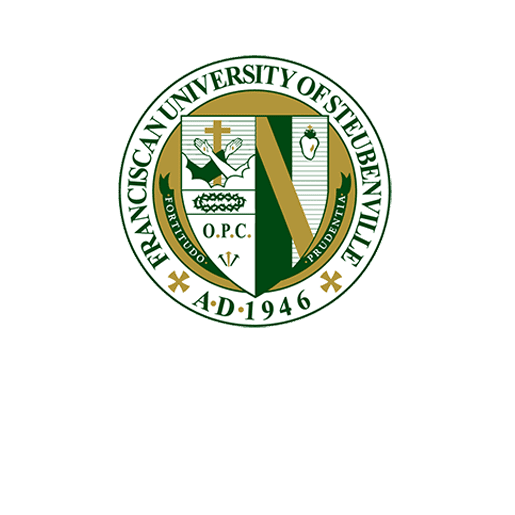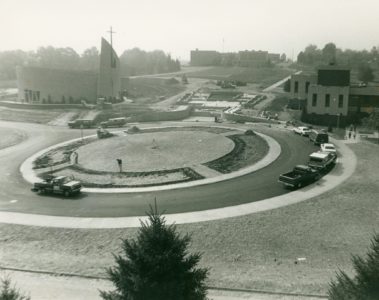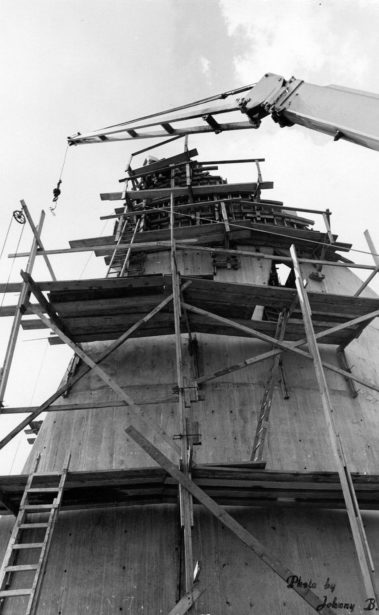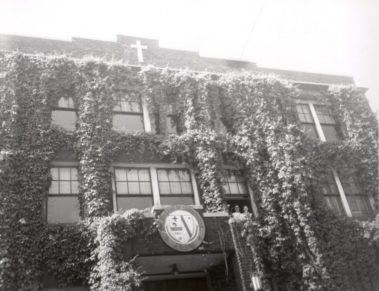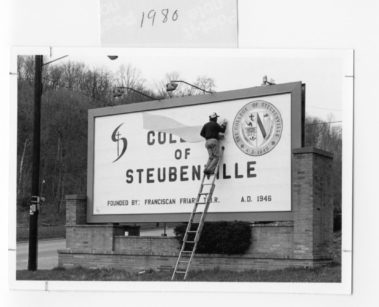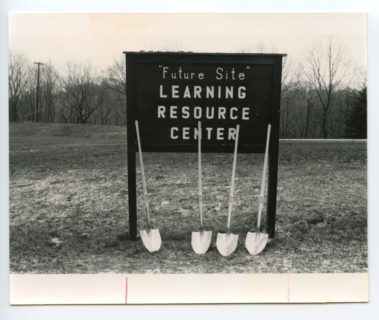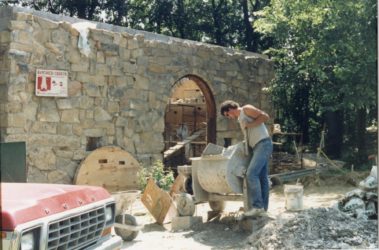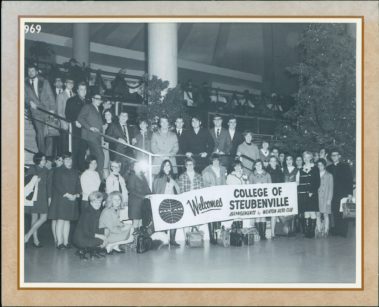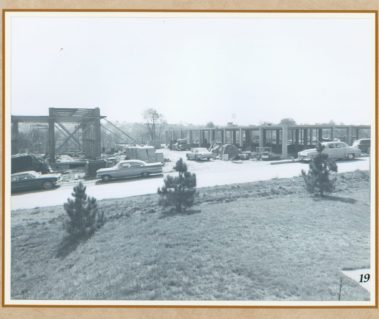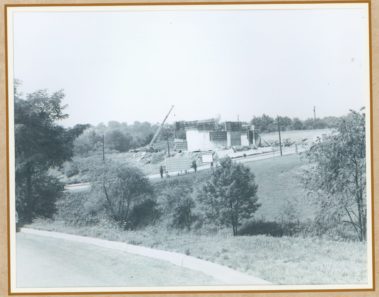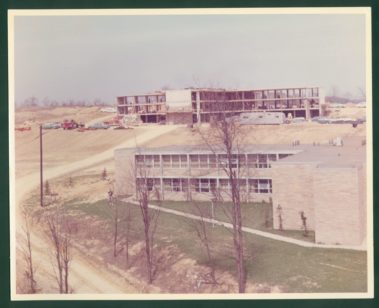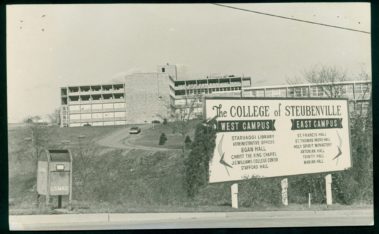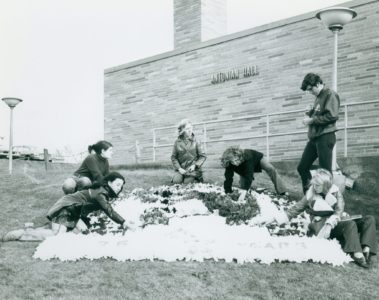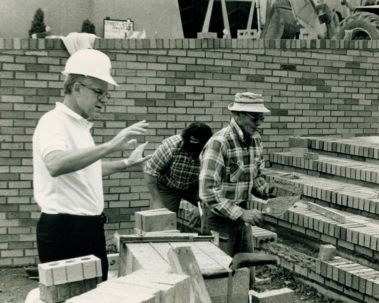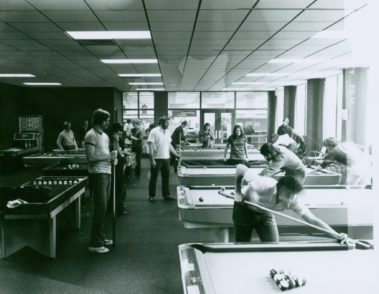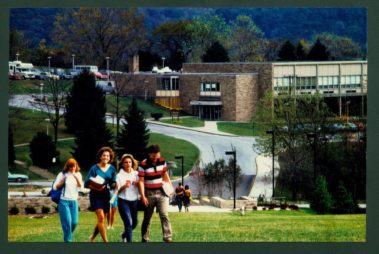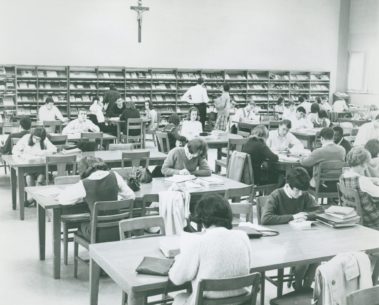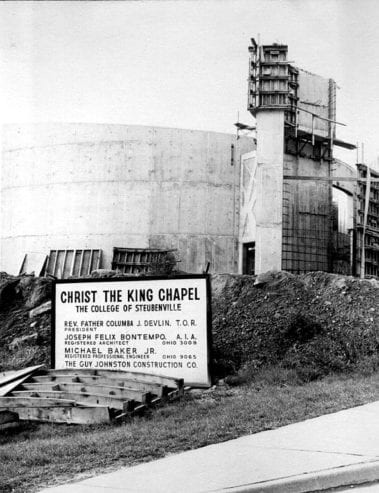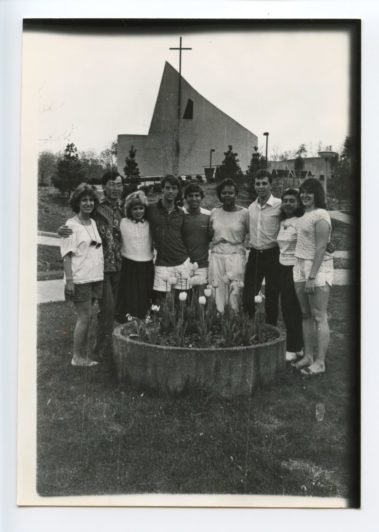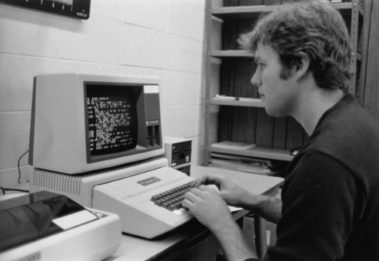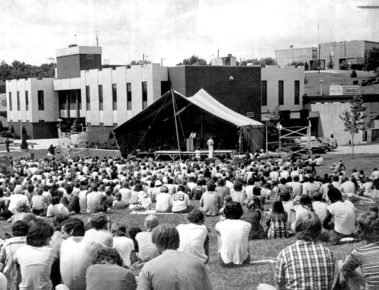Franciscan University was born on December 10, 1946, a product of the optimism in the country that accompanied victory in World War II. Indeed, most members of the first class were veterans of the war and were making use of the GI Bill to pay for their education. The school in which the 258 students (including seven women) enrolled was known officially as the College of Steubenville, and its origins were distinctly humble.
Study Abroad in Austria
Tuition & Financial Aid
International Students
Living Your Faith
Housing & Dining
Student Opportunities
Student Resources
- Our History
- Building on Faith
- A New Campus
- Typical Problems, Atypical Responses
- Transforming the Culture
- Furthering the Mission
- First Alumnus as President
- The Third Order Regular
- Recent Honors
- Founding Facts

The Third Order Regular, the TORs, had already achieved surprising success with St. Francis College in Loretto, Pennsylvania, and the friars not only accepted the challenge of starting a college in Steubenville, they offered to provide their own financing.
Father Dan Egan, TOR, arrived in Steubenville and set to work on the daunting task of starting a college from scratch. Assisted by Father Regis Stafford, TOR, Father Egan began by purchasing the Knights of Pythias Building on Washington Street to serve as the grandly named Main Campus, along with several buildings that became the North Campus.
From the beginning, there was a feeling of making do. Owing to the considerable walking distances between the two campuses, students were given the unusually long period of 15 minutes between classes.
The College library was placed in the basement of the Pythias Building, a spot that had once been an infamous nightclub. There were also makeshift classrooms converted from a Quonset hut and a former Army barracks.
In a speech delivered just before the school opened its doors, Father Egan described his vision for the College.
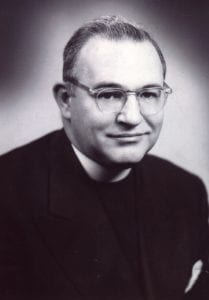
His words had a timeless relevance: “The College has a two-fold purpose . . . to give those who enroll here a thorough sense of values designed to train men for a full life which occupies 24 hours a day, not simply eight hours spent in the shop or office. It also aims to contribute to the development and the welfare of a man’s nature, recognizing that he has not only a body but an immortal soul.”
The curriculum reflected this goal, with mandatory courses in theology and philosophy; non-Catholics were exempted from theology requirements, but they still had to take such courses as Basic Truths 101, Character Formation 102, and six hours of Social Psychology.
In June 1950, the first graduating class was honored with 17 different events, including a solemn Mass at St. Peter’s Church and a June 8 commencement at Steubenville High School.
Two years later, one of the long-range hopes of Father Egan was realized–40 acres of hilltop land a mile from downtown Steubenville was secured to provide for a brand new campus. Sadly, Father Egan did not live to preside over the new era. In March 1959, smoke from a fire in the friary claimed his life.
Throughout the 13 years of Father Egan’s leadership, the College had been tiny, but it was blessed by an abiding Catholic spirit and a genuine commitment to the future. In 1949, for example, the first Founders’ Day Dinner was held at the Fort Steuben Hotel and the first Board of Advisors was formed. Father Egan also attracted a faculty of talented scholars and encouraged an Athletic Department that included intercollegiate football and basketball.
The football team suffered through several losing seasons—save for 1947 when it had a record of 4-4-1—and was disbanded in 1950 because of the prohibitive costs of the sport. The basketball team, meanwhile, was surprisingly successful throughout the decade, once winning 56 home games in a row under coach Hank Kuzma and earning the title “Number One Small College Basketball Team in the U.S.” with a record of 24-1 in 1958.
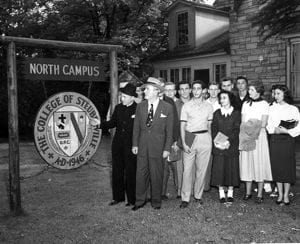
In the summer of 1959, Father Kevin R. Keelan, TOR, began the first of two terms as president of the College (1959-62 and 1969-74). Keelan’s first term was marked by the fulfillment of Father Egan’s plans for a new campus.
In 1959, a groundbreaking was held for a complex of six new buildings on the hilltop, and two years later the College completed its move from downtown Steubenville. The new campus marked a period of progress that was continued by Father Keelan’s immediate successor, Father Columba J. Devlin, TOR, who served as president from 1962 to 1969. In 1965, the graduating class topped 100 students for the first time. By 1969, the campus boasted 10 buildings, including dormitories, Holy Spirit Monastery, laboratories, and the distinctive Christ the King Chapel.
The progress on the campus was matched by a growth in the student population. By 1970, there were 1,111 total students, permitting the College to pay off its debts.
The apparently endless period of development could not be sustained as a financial and cultural storm broke during the second presidency of Father Keelan.
First, the College ceased to be the sole educational center in the Steubenville area. Four other state-supported schools had been established in the previous years, all of them offering lower tuition. Combined with the general decline in births at the end of the baby boom, there was a steady drop in enrollment.
Financial shortfalls from the drop in enrollment prompted layoffs among the faculty and staff and cutbacks in programs.
In an effort to attract a wider cross-section of students, the curriculum was revised. The once solid requirements of philosophy and theology were abolished: Philosophy ceased being mandatory at all, and only six credit hours of theology were necessary for graduation.
Equally troubling was the gradual erosion of authentic Catholic spirit. Encouraged by the changes in the curriculum, some students petitioned that unlimited open visitation be introduced in the dorms. Father Keelan refused the appeal and resisted the spiritual decline despite his increasing health problems, but it was clear that a new direction was needed for the College.
The lowest point came during opening day of the 1973 fall semester when a meager six students and eight members of the faculty attended the first Mass of the term. Soon after, Father Keelan asked to be replaced due to illness.
In 1974, the Board of Trustees chose Father Michael Scanlan, TOR, to succeed Father Keelan. He had served as dean of the College from 1964-69 and was well known as one of the leaders of the Catholic charismatic renewal.
Father Scanlan was the only one of the four candidates to hold the opinion that the College could actually stay open without being combined with a state school. From the start, Father Scanlan made it clear that things were going to be different.
Instead of approaching the needs of the College from academic and administrative directions, he went straight to the heart of the problem. The College of Steubenville needed a profound Catholic renewal.
As he wrote in his autobiography, Let the Fire Fall: “What was needed was a series of changes over time that would eventually alter the system and transform the whole atmosphere of the College. This would be a step-by-step process, but it would be guided by a clear understanding of the eventual goal—a spiritual transformation.”
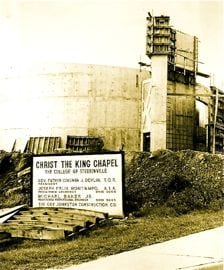
Father Mike, as he was soon called, considered student life his top priority. He spent his first semester in fall 1974 getting to know the students—playing seven intramural sports with them, attending their plays, concerts, and sporting events, showing up at any party he heard about, invited or not.
What he discovered were many students struggling to come to terms with the dramatic cultural and moral shifts of the sixties and seventies, testing authority, and haunted by a desperate sense of loneliness and isolation. Sunday morning Mass was poorly attended, and a petition was sent to the new president requesting that it be moved to afternoon. Other petitions followed, such as a renewed demand for open dorms and an end to the campus curfew. These problems were no different from those of most Catholic and secular universities at that time.
But Father Scanlan’s response was.
Rather than merely refusing the Mass petition, Father Scanlan declared that he would be celebrating the Sunday liturgy himself. And while other administrators—even at many Catholic colleges—caved in to student petitions for co-ed dorms and against curfews, he rejected them.
Instead he inaugurated “households,” an innovative residence life program requiring students to form small groups for ongoing communal prayer, sharing, and mutual support. Despite some initial resistance, the households proved effective in ending the severe isolation on the part of students. Households remain a cherished tradition today, with more than 900 students belonging to 50 households.
Other resources were spent on campus ministry and student life, as well as youth conferences that also attracted new students. Recruitment targeted young Catholics who were active in the charismatic renewal or who wanted to attend a college dedicated to authentic Catholicism. In time, the entire atmosphere of the College was reformed, in part by the influx of excited new students.
The restoration of campus life meant that other improvements were delayed, and the changes came at a high price. By 1976, the enrollment was so low that some faculty assumed the College’s days were numbered. Others disagreed with Father Scanlan’s program, and many members of the student body, the faculty, and the administration resigned or left for other schools. Some of the administrators chosen to replace them also departed.
Anger was also felt locally and among some alumni when the expenses involved in athletics coupled with low attendance at games prompted the school to abandon its participation in basketball in 1981.
Slowly, Father Scanlan assembled a team that could implement his vision for the school as a place of vigorous Catholicism and academic excellence. The fruits of their efforts were apparent in 1980 when the College earned official designation as the University of Steubenville, through the addition of several graduate programs, including an MBA, MS in Education, and MA in Theology.
In 1985, in recognition of the Catholic Franciscan spirit suffusing the school, the Board of Trustees voted to change the name to Franciscan University of Steubenville. Also in 1985, the Pre-Theologate Program began. At the time, it was a bold experiment that sought to encourage vocations by providing men with a community setting to discern the priesthood and religious life, while they remained fully involved as students. Known today as the Priestly Discernment Program, 115 of the program’s graduates from 2004-2014 alone have entered a seminary or religious order.
By 1983, the University had paid off its entire debt, inaugurating a new era of construction. The John Paul II Library was dedicated in 1987. The next year, the one-time Ohio Valley Skating Rink was purchased and converted into the St. Joseph Center for offices and classrooms. In 1992, the Finnegan Fieldhouse was dedicated, boasting courts for basketball and racquetball, a weight room, and an exercise room.
By 1989, full-time undergraduate student enrollment was 1,179, surpassing at last the previous high set in 1970. The vibrant quality of the faith was also attracting faith-filled Catholic professors who often applied at the encouragement of students or priests returning home from the annual summer Priests’ Conferences held every year since 1975. Father Scanlan interviewed every applicant personally and found scholars who shared his enthusiasm for “dynamic orthodoxy,” an educational approach marked by fidelity to the Church and openness to the Holy Spirit.
In 1989, the members of the theology faculty along with the friars at the University were the very first professors and campus ministers in the United States to publically make the newly formulated Profession of Faith and Oath of Fidelity called for in the revised Code of Canon Law.
In 1991, the University secured the use of a recently restored 650-year-old Carthusian monastery, the Kartause Maria Thronus Iesu (“Monastery of Our Lady, Throne of Jesus”), for students to spend a memorable semester studying in picturesque Gaming, Austria, in the foothills of the Alps. The following year, the University started the Language and Catechetical Institute (LCI) at Gaming to provide desperately needed catechetical training to teachers from Eastern Europe. In 1996, the University helped to launch the International Theological Institute for Studies on Marriage and the Family (ITI) at Gaming.
A capital campaign initiated in 1996 provided funding for SS. Cosmas and Damian Science Hall, the first academic building dedicated to the sciences. Completion of the three-story, 43,000-square-foot building continued the University’s mission to prepare students who are grounded in a reverence for the dignity of human life for careers in medicine and the sciences.
In 1999, Father Scanlan made the decision to step down as president of the University. He was asked by the trustees, however, to serve as chancellor and bore the title president emeritus. Taking the helm of a college in 1974 plagued with debt and lacking spiritual vitality, Father Scanlan was able to bequeath to his successor a university with a world-renowned faculty, a student body of over 2,000, and a tradition of dynamic orthodoxy.
Appointed the fifth president of Franciscan University in August 2000, Father Terence Henry, TOR, held to the University’s legacy while moving the school into the future. He promoted Pope John Paul II’s call, echoed by Pope Benedict XVI, for Catholics to influence every aspect of the culture.
Father Henry introduced new majors in catechetics, sacred music, legal studies, and a concentration in bioethics for the MA Philosophy Program, among other majors. He also established the Franciscan University Institute of Bioethics to provide a solid Catholic response to secular assaults on the dignity of human life, marriage, and other human life issues.
Early in his presidency he introduced the Commuter Grant Program, which helped more local students attend Franciscan. With approval from the Board of Trustees, Father Henry oversaw the University’s re-entry into intercollegiate sports in 2007, as the Barons became NCAA Division III members and joined the Allegheny Mountain Collegiate Conference.
Today, student-athletes in 16 men’s and women’s sports have the opportunity to transform the secular sports culture with the light of Christ as players and later as parents, coaches, or athletic directors.
The physical campus doubled in size during Father Henry’s presidency, with the purchase of adjacent property bringing the total acreage to 249, allowing the beautification of lower campus along University Boulevard, and ensuring plenty of space for further growth. A new residence hall, the 48,000-square-foot SS. Louis and Elizabeth Hall, opened in fall 2007 as home to 177 students.
Father Henry undertook the most ambitious capital campaign in the University’s history, with a $25 million goal earmarked for student scholarships, a new friary, and a chair in bioethics among the top needs. In 2010, the campaign concluded, having raised $31 million.
Knowing how important it is for young Catholics to take up key leadership positions in business, politics, media, education, health care, and “every occupation proper to Christian laity,” the University founded the Center for Leadership in fall 2011. The four-year program prepares a select group of students to become Christ-centered leaders who understand the dignity of the human person and the role of faith in shaping the social order.
Following extensive evaluation by the faculty, a new liberal arts core curriculum was unveiled in 2012. The new core curriculum ensures a common grounding for all students not only in theology and philosophy as called for in Ex corde Ecclesiae, but also in literature, American founding principles, history, fine arts, natural science, and social science.
Father Henry praised the revised core, saying it “exposes our students to more of the fundamental knowledge and critical authors they need to become well-educated Catholics.” In a 2012 letter to friends and alumni, Father Henry wrote, “The age of casual Catholicism is over. The age of heroic Catholicism has begun.”
Toward that end, he directed Franciscan University’s 2012 lawsuit opposing the federal government’s HHS mandate that would force the University to provide health insurance coverage that violates its religious principles.
Another example of his commitment to the life issues: Father Henry made it a point, no matter what the weather, to attend every March for Life in Washington, D.C., walking with Franciscan students, alumni, and friends under the green Franciscan banner.
In June 2013, Father Henry’s 13-year tenure as president concluded when he stepped down to become the University’s second chancellor. His successor inherited a University that had grown in every way—from new buildings and enrollment that now consistently topped 2,400 students annually—to the many programs and initiatives that strengthened Franciscan’s Catholic identity and solidified its position as a leader in Catholic higher education.
When Father Sean O. Sheridan, TOR, took the reins on June 1 and was installed on October 10, 2013, as Franciscan University’s sixth president, he pledged to advance Franciscan “both as a university dedicated to academic excellence and as a university that is passionately Catholic in its very being.”
Father Sheridan was well familiar with the University’s dual mission, having taught theology at Franciscan the previous year and served on the Board of Trustees from 2008-2012. A graduate from the University of Pittsburgh School of Pharmacy, in 1990, he earned his juris doctor from the University of Pittsburgh School of Law and spent 10 years as a practicing attorney before he entered the Franciscan Third Order Regular.
Ordained to the priesthood in December 2006, he holds both a licentiate and a doctorate in canon law from The Catholic University of America School of Canon Law.
In his inaugural address he pledged to further the University’s multi-fold mission in academics, evangelization, and dynamic orthodoxy, and he began to find new ways to further that mission almost immediately.
The capstone event to his inauguration events was a two-day Inaugural Symposium that examined Catholic higher education’s role in the new evangelization.
In fall 2013, he announced the start of the Veritas Center for Ethics in Public Life. The center gives a greater voice in the public square to Franciscan University’s scholars through their research, academic conferences, and especially their writings in the popular media on the most pressing ethical issues in contemporary culture, including marriage and sexuality, war and peace, life and death, as well as economic and social justice issues.
Also in the first year of his presidency, Father Sheridan announced an Engineering Dual-Degree Program, the expansion of online learning with a faith-based MBA and an online Master of Arts in Catechetics and Evangelization, and the revitalization of Franciscan University Press.
In April 2014, Father Sheridan announced a transfer of ownership that gave Franciscan University full access to all of the Kartause’s artistic and spiritual treasures and will allow for future growth of the popular study abroad program.
Recognizing the importance of the spiritual life of the University community, Father Sheridan created a new Pastoral Care and Evangelization Department that placed the pastoral care of students and all internal and external evangelization programs under one administrative department.
When Father Sheridan resigned in 2019, he left behind these outstanding achievements as well as a legacy that includes the Finnegan Fieldhouse expansion, the Franciscan Square development, the Franciscan Catechetical Institute, the addition of St. Junipero Serra Residence Hall, and an online Master of Catholic Leadership.
In a unanimous decision, the Board of Trustees of Franciscan University of Steubenville elected Father David Pivonka, TOR, as the school’s seventh president on May 21, 2019.
As Franciscan’s first alumnus president, he brings a unique array of perspective, experience, and qualifications to this role. His work as a nationally known preacher and evangelist combined with prior senior-level administrative experience at Franciscan University will serve the University well as he assumes the top pastoral and leadership duties.
In the news release announcing his election, Father Pivonka said, “It’s both humbling and an honor to be chosen to lead Franciscan University of Steubenville. Over 30 years ago, I first arrived at Franciscan as an undergrad and received an outstanding education as well as life-changing spiritual formation as part of a dynamic, Catholic intellectual and faith community. A lot has changed in our culture in the last 30 years, but Franciscan University continues its mission to provide a superior education in a vibrant faith community where students and parents alike can be confident in their choice of Franciscan University.
“I look forward to working with one of the finest faculties in the country and an exceptional staff to assure that our Franciscan University graduates are prepared intellectually, professionally, and spiritually to be a light to a world in desperate need.”
The Franciscan Friars who founded and have operated Franciscan University since 1946 are members of the Third Order Regular of St. Francis of Penance (TOR) of the Province of the Most Sacred Heart of Jesus.
The third order traces its origins to St. Francis of Assisi who founded a single Franciscan family, with three branches, in the 13th century. The first was the Order of Friars Minor, for men; the second was the Poor Clares, for women; and the third was for men and women living in their own homes or other places.
During St. Francis’ time, many members of the third order were not married, and performed works of mercy or lived in solitude while frequently gathering together for prayer and support.
From this beginning emerged the male branch of the Third Order Regular of St. Francis of Penance, following the amalgamation in 1448 of various smaller communities of men spread across Italy.
Over the next centuries, the TORs founded communities throughout Europe and in Africa, South America, Mexico, India, Sri Lanka, and the United States.
The province from which the founders of Franciscan University were sent was established in 1910 at Loretto, Pennsylvania, with the call to promote Catholic education among its several apostolates.
Franciscan University remains one of the most respected Catholic universities in the United States. Since 2001, U.S. News & World Report’s guidebook on “America’s Best Colleges” has ranked Franciscan University in the elite “top tier” of Midwestern universities.
In addition to a high overall ranking, Franciscan University is ranked among the top 10 Midwest universities for Overall Graduation Rate and Freshman Retention Rate, indicating a strong university community that welcomes and encourages the success of its students.
Also notable is that U.S. News & World Report ranks Franciscan University in the top four percent of all U.S. universities for its study abroad program in Gaming, Austria, which draws over 150 students each semester, with additional study abroad opportunities in Avila, Spain, and Oxford, England.
Franciscan has also achieved national recognition from the Cardinal Newman Society, which includes Franciscan University in each edition of its select guide to “faithfully Catholic” universities.
Since 2011, Kiplinger Personal Finance Magazine has included Franciscan University of Steubenville as one of its “best values” in private higher education, ranking it 55th among the top 100 private universities in the nation for providing quality academics at a reasonable cost.
Franciscan has also achieved national recognition from Young America’s Foundation, which rates Franciscan as one of the top 15 conservative colleges in the nation, and The Templeton Honor Roll for Education in a Free Society considers Franciscan one of the 13 colleges that are “best in liberal arts education.”
Five Franciscan faculty have received prestigious Fulbright Scholarships to conduct research or teach overseas; three recent Franciscan alumni have also won Fulbright grants.
- Founded in 1946 by the first bishop of Steubenville
- The first students were mostly GIs returning from World War II
- There were seven women among the first students
- The first semester was completed in under one month
